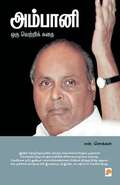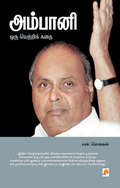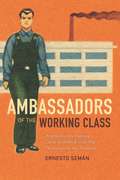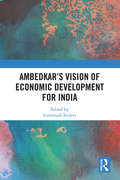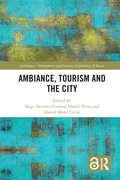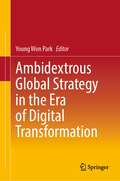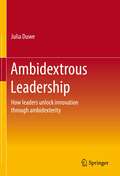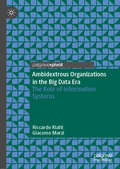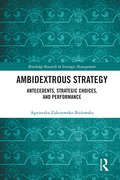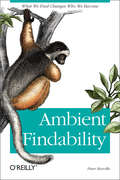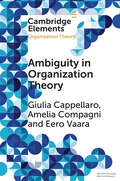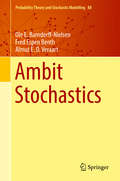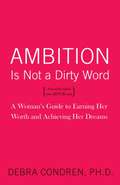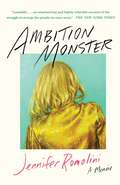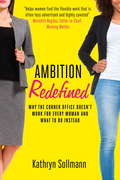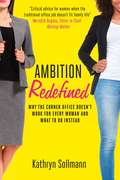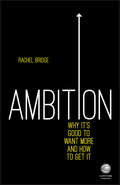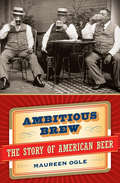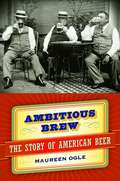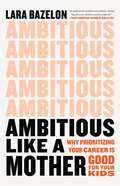- Table View
- List View
Ambani
by N. ChokkanThis book is a biography of Dhirubai Ambani who won the prestigious best industrialist of India of the 20th century award from "Business Barons" in 1999 and who started his life from a humble beginning with moderate education to achieve Himalayan victory in business world with high enterprising ability.
Ambani: Oru Vetri Kadhai
by N. ChokkanThis book tells the success story of the Indian industrialist Dhirubai Ambani.
Ambani: அம்பானி
by என். சொக்கன்"இந்தியாவில் தொழில்முனைவோராக விரும்புபவர்களுக்கெல்லாம் முக்கிய ஆதர்சமாகத் திகழ்பவர் திருபாய் அம்பானி. மிகச் சாதாரணப் பின்னணியிலிருந்து தொடங்கி படிப்படியாக முன்னேறி ரிலையன்ஸ் எனும் மாபெரும் சாம்ராஜ்ஜியத்தை உருவாக்கியவர் திருபாய் அம்பானி. துணிமணி வியாபாரத்திலிருந்து ஆரம்பித்து, அதன்பின் துணிகளைத் தயாரித்து, பின் பாலியெஸ்டர் வியாபாரம், பாலியெஸ்டர் உற்பத்தி, அதன்பின் பாலியெஸ்டர் உற்பத்திக்கான மூலப்பொருள்களை உருவாக்குவது, அந்த மூலப்பொருள்களின் ஆதாரமான பெட்ரோலிய சுத்திகரிப்பு, அங்கிருந்து பெட்ரோலையே தரையிலிருந்தும், கடலுக்கு அடியிலும் தோண்டுவது என்று படிப்படியாக, பார்த்துப் பார்த்து தன் தொழிற்சாலைகளைக் கட்டியவர். அம்பானி 70 mm அளவுக்கு விரிந்த திரையில் கனவு கண்டார். பிரம்மாண்டமாக மட்டுமே யோசித்தார். அதன் விளைவுதான் இன்று ரிலையன்ஸ் இந்தியாவிலேயே மிகப்பெரிய தனியார் நிறுவனமாக உள்ளது. ஆனால் இத்தனையும் அதிர்ஷ்டத்தால் வந்ததல்ல. உழைப்பால், தைரியத்தால், முயற்சியால் வந்தது. அதே சமயம் காலத்துக்குத் தகுந்தாற்போல அரசுகளையும் அதிகாரிகளையும் தனக்குச் சாதகமாக வளைத்துக் கொள்வதன் மூலமும் அரசு உத்தரவுகளை தன் வசதிக்கேற்றவாறு புரிந்துகொள்வதன் மூலமும் அம்பானி தன் நிறுவனத்தை வளர்த்தார். அம்பானி, தன்னை எதிர்ப்பவர்களை அவர்களது ஆயுதங்களைக் கொண்டே மழுங்கடித்தார். இன்றைய காலகட்டத்தில் திருபாய் அம்பானியின் சில செயல்கள் நமக்கு ஏற்புடையதாக இருக்காது. ஆனால் அவரது விடாமுயற்சி, தன்னம்பிக்கை, இந்தியா மீதான பற்று, சக ஊழியர்கள் மீதான மரியாதை, தொழில் மீதான ஆழ்ந்த பக்தி ஆகியவை இன்றைக்கும் நம் அனைவருக்கும் வழிகாட்டக் கூடியவை. இந்தப் புத்தகம் அம்பானியின் வாழ்க்கை வரலாறு மட்டுமல்ல, கடந்த நாற்பதாண்டுகளில் இந்தியாவின் தொழில்துறையின் வரலாறும் இதில் அடங்கியிருக்கிறது. எந்தவொரு சுய முன்னேற்ற நூலைக் காட்டிலும் பன்மடங்கு அதிகமான பலனை இந்தப் புத்தகத்தினைப் படிப்பதன் மூலம் ஒருவர் அடைய முடியும். இது நிஜமான வாழ்க்கை, வெறும் ஏட்டுச் சுரைக்காய் அல்ல." கிழக்கு பதிப்பகம் | Kizhakku pathippagam
Ambassadors of the Working Class: Argentina's International Labor Activists and Cold War Democracy in the Americas
by Ernesto SemánIn 1946 Juan Perón launched a populist challenge to the United States, recruiting an army of labor activists to serve as worker attachés at every Argentine embassy. By 1955, over five hundred would serve, representing the largest presence of blue-collar workers in the foreign service of any country in history. A meatpacking union leader taught striking workers in Chicago about rising salaries under Perón. A railroad motorist joined the revolution in Bolivia. A baker showed Soviet workers the daily caloric intake of their Argentine counterparts. As Ambassadors of the Working Class shows, the attachés' struggle against US diplomats in Latin America turned the region into a Cold War battlefield for the hearts of the working classes. In this context, Ernesto Semán reveals, for example, how the attachés' brand of transnational populism offered Fidel Castro and Che Guevara their last chance at mass politics before their embrace of revolutionary violence. Fiercely opposed by Washington, the attachés’ project foundered, but not before US policymakers used their opposition to Peronism to rehearse arguments against the New Deal's legacies.
Ambedkar’s Vision of Economic Development for India
by Gummadi SrideviThis book discusses Ambedkar’s engagements with the issues of social justice, economic development and caste enclosures. It highlights his significant contributions in the field of trade, public finance and monetary economics, Indian agriculture, education, among others, and examines their relevance in contemporary India. The volume analyses the basic theoretical conceptions in Ambedkar’s writings which attributed a key role to industrialisation, favoured economic planning and progressive labour laws. It reaffirms these theories and illustrates that focus on social and economic democracy promotes productivity, equitable distribution of wealth and an inclusive society. Through an analysis of Ambedkar’s interdisciplinary works, the book discusses issues of rural poverty, lagging infrastructure growth, the persistence of an exploitative ruling class and the economic and social marginalisation of the downtrodden which are still relevant today. Further, it offers solutions for a restructuring of the society under democratic principles which would recognise the basic right of all to social dignity, and devise means to insure against social and economic insecurity. Insightful and authoritative, this volume will be of great interest to students and researchers of economics, sociology, development studies and social exclusion.
Ambiance, Tourism and the City (Ambiances, Atmospheres and Sensory Experiences of Spaces)
by Iñigo Sánchez-Fuarros Daniel Paiva Daniel Malet CalvoAmbiance, Tourism and the City considers how tourism and urban development affect the lived ambiances of contemporary cities around the world. As most of the existing literature on sensory atmospheres says little about the intersection between tourism and atmospheric production, this book affirms the centrality of the notion of ambiance as a mode of inquiry into the making and remaking of urban places for tourist consumption. The book takes the reader into the sensory worlds of a traditional Italian marketplace, a jungle park in Kuala Lumpur, a slum in the Colombian city of Medellín, or the "sun and sand" tourism destinations in Southern Spain, among other case studies. It offers new insights into the impact of tourism on the urban environment from multidisciplinary perspectives and a wide range of geographical regions across Europe, North America, Asia, and South America. Through these contemporary case studies, the book further deepens our understanding of the ways in which "ambiances" and "atmospheres" pervade the physical regeneration and sensory transformation of contemporary tourist destinations. Conversely, this book offers insights on the effects of tourism on everyday urban experience. By bringing together a diverse group of scholars and case studies to present a global perspective on the atmospheric production of the tourist city, this book is to serve as a valuable reference tool for researchers and undergraduate and postgraduate students with an interest in urban ambiances, tourism, cultural geography, and urban planning.
Ambiance, Tourism and the City (ISSN)
by Iñigo Sánchez-Fuarros Daniel Paiva Daniel Malet CalvoAmbiance, Tourism and the City considers how tourism and urban development affect the lived ambiances of contemporary cities around the world. As most of the existing literature on sensory atmospheres says little about the intersection between tourism and atmospheric production, this book affirms the centrality of the notion of ambiance as a mode of inquiry into the making and remaking of urban places for tourist consumption. The book takes the reader into the sensory worlds of a traditional Italian marketplace, a jungle park in Kuala Lumpur, a slum in the Colombian city of Medellín, or the "sun and sand" tourism destinations in Southern Spain, among other case studies. It offers new insights into the impact of tourism on the urban environment from multidisciplinary perspectives and a wide range of geographical regions across Europe, North America, Asia, and South America. Through these contemporary case studies, the book further deepens our understanding of the ways in which "ambiances" and "atmospheres" pervade the physical regeneration and sensory transformation of contemporary tourist destinations. Conversely, this book offers insights on the effects of tourism on everyday urban experience.By bringing together a diverse group of scholars and case studies to present a global perspective on the atmospheric production of the tourist city, this book is to serve as a valuable reference tool for researchers and undergraduate and postgraduate students with an interest in urban ambiances, tourism, cultural geography, and urban planning.
Ambidextres Innovationsmanagement in KMU: Praxisnahe Konzepte und Methoden
by Sabrina Weber Stephan Fischer Claus Lang-Koetz Annika Reischl Anina KuschDieses Open-Access-Buch vermittelt praxisnahes Wissen über Konzepte und Methoden für das Innovationsmanagement in kleinen und mittleren Unternehmen (KMU). Es werden Lösungsansätze für Herausforderungen im gesamten Innovationsprozess – von der strategischen Orientierung über Ideengewinnung, -bewertung und auswahl bis zur Umsetzung – aufgezeigt. Der Hauptfokus liegt auf dem Umgang mit Ambidextrie: Vorhandene Ressourcen sind zu nutzen, um das Tagesgeschäft effizient zu bewältigen und inkrementelle Innovationen zu entwickeln (Exploitation). Gleichzeitig soll offen nach ganz neuen und oftmals radikalen Innovationen gesucht werden (Exploration). Ein Kapitel zeigt, wie KMU ihr Innovationsmanagement auf das Thema Nachhaltigkeit ausrichten können. Auf der Webseite der Hochschule Pforzheim finden sich zahlreiche vertiefende Zusatzmaterialien. Der InhaltStrategische Orientierung/ProblemidentifizierungIdeengewinnung, -bewertung, -auswahl und -umsetzungAmbidextrie und das hybride VorgehenZukunft des Innovationsmanagements: Nachhaltigkeit
Ambidextrous Global Strategy in the Era of Digital Transformation
by Young Won ParkThis book deals with the importance of ambidexterity in innovation activities and global strategies. Ambidextrous global strategy (AGS) is crucial for global firms in the turbulent twenty-first century. Here, AGS is defined as simultaneous achievements of global integration and local adaptation, or responsiveness, through utilization of a firm’s core facilities and organizational capabilities. To illustrate the specific implementation mechanism, a framework of AGS with global market strategy and organizational capability is shown for the purpose of analysis. There is also a focus on effective ambidextrous business strategies for the digital transformation era. Distinctive features of the book include, first, a framework of ambidextrous innovation and AGS. Second, there are analyses of examples of many industries to implement ambidexterity strategies, including Korean shipbuilding firms, Korean and Japanese steel firms, LCD panel flat-glass manufacturers, Japan’s trucking industry, agricultural corporations, and other Japanese manufacturing firms. Finally, the book focuses on effective ambidextrous business strategies for the digital transformation era with the integration of open and closed innovation. The book presents specific business strategies for survival in the digital transformation era and then suggests an architectural analysis using artificial intelligence (AI) for the realization of AGS. The target readership is made up of academics, students, and practitioners in the areas of global management, organizational theory, and strategic management. Especially for those readers, the book clarifies the critical practices and business strategies of innovative global firms in the era of digital transformation.
Ambidextrous Leadership: How leaders unlock innovation through ambidexterity
by Julia DuweThis book prepares leaders for fundamental change processes of organizations. In times of radical changes and unplanned crises, ambidexterity has become a key competence of global companies. Ambidextrous organizations manage to improve their core business, while at the same time opening up new business fields for the future. To unlock innovation next to the running business, it is essential for leaders to be ambidextrous. How these balanced leaders can operate with two different styles is demonstrated in numerous practical examples and tips for successful implementation. The book illustrates how the trade-off can be turned into an elegant balancing act. Learn how to become an ambidextrous leader in this standard work on ambidexterity and leadership. · Ambidexterity as a leadership approach for the digital transformation· Consciously shaping the digital change process· Enabling leaps in innovation· Driving evolution and revolution simultaneously· The relevance of ambidextrous leadership in times of crisis The book provides easy-to-implement courses of action for executives to consciously and actively shape change, to inspire people in companies to release their creative potential and to make the leap into the future as an organization. The book also addresses the consequences of the COVID-19 pandemic on crisis management. It documents how ambidextrous leadership skills are becoming a key competence in times of crisis.
Ambidextrous Organizations in the Big Data Era: The Role of Information Systems
by Riccardo Rialti Giacomo MarziAddressing the effect of big data analytics-capable information systems on organizational ambidexterity, this book investigates how these systems can be used to enhance organizational agility and flexibility, generally considered to be two key determinants of organizational ambidexterity. With a focus on the opportunities for businesses rather than the burden that big data can represent, the authors highlight the impact of big data on ambidextrous organizations and how current organizational structures can be modified in order to improve big data analytics and implement big data-capable information systems.
Ambidextrous Organizations: Leading Evolutionary and Revolutionary Change
by Michael L. Tushman Charles A. O'ReillyWhile less successful firms react to environmental jolts, the more successful ones proactively initiate innovations that reshape their market. This chapter discusses the importance of managing an organization that can succeed at both incremental and radical innovation.
Ambidextrous Strategy: Antecedents, Strategic Choices, and Performance (Routledge Research in Strategic Management)
by Agnieszka Zakrzewska-BielawskaStrategies of enterprises evolve with the development of strategic management theory and new concepts, models, and outlooks that emerge with it. The concept of ambidexterity is a relatively new approach to business development strategies, which involves simultaneous exploration and exploitation activities to ensure the success of the company and a relatively sustainable competitive advantage. This begs the question as to whether the ambidextrous strategy is the right choice for all enterprises, and if not, what determines its choice. This book identifies and systematizes antecedents for choosing ambidextrous strategy, including factors related to the uncertainty of the environment, its dynamics, complexity, and unpredictability, intra-organizational factors, those related to resources, organizational structure, and behavioral context, as well as those related to strategic leadership. It examines the outcomes of implementing ambidexterity from the perspective of financial and market performance and assesses the choices of companies operating in Poland from the perspective of the impact that particular antecedents had and the outcomes achieved, providing knowledge and guidance on the circumstances in which choosing the ambidextrous strategy brings the best results. The book presents the research findings to date, the cognitive gaps that still exist, and the directions for further research. It is intended for scientific circles, doctoral and management students and a wide range of managers, who have to make difficult strategic choices aimed, on the one hand, at increasing the efficiency of the company and, on the other, at seeking new paths of growth.
Ambient Findability: What We Find Changes Who We Become
by Peter MorvilleHow do you find your way in an age of information overload? How can you filter streams of complex information to pull out only what you want? Why does it matter how information is structured when Google seems to magically bring up the right answer to your questions? What does it mean to be "findable" in this day and age? This eye-opening new book examines the convergence of information and connectivity. Written by Peter Morville, author of the groundbreaking Information Architecture for the World Wide Web, the book defines our current age as a state of unlimited findability. In other words, anyone can find anything at any time. Complete navigability.Morville discusses the Internet, GIS, and other network technologies that are coming together to make unlimited findability possible. He explores how the melding of these innovations impacts society, since Web access is now a standard requirement for successful people and businesses. But before he does that, Morville looks back at the history of wayfinding and human evolution, suggesting that our fear of being lost has driven us to create maps, charts, and now, the mobile Internet.The book's central thesis is that information literacy, information architecture, and usability are all critical components of this new world order. Hand in hand with that is the contention that only by planning and designing the best possible software, devices, and Internet, will we be able to maintain this connectivity in the future. Morville's book is highlighted with full color illustrations and rich examples that bring his prose to life.Ambient Findability doesn't preach or pretend to know all the answers. Instead, it presents research, stories, and examples in support of its novel ideas. Are we truly at a critical point in our evolution where the quality of our digital networks will dictate how we behave as a species? Is findability indeed the primary key to a successful global marketplace in the 21st century and beyond. Peter Morville takes you on a thought-provoking tour of these memes and more -- ideas that will not only fascinate but will stir your creativity in practical ways that you can apply to your work immediately."A lively, enjoyable and informative tour of a topic that's only going to become more important."--David Weinberger, Author, Small Pieces Loosely Joined and The Cluetrain Manifesto"I envy the young scholar who finds this inventive book, by whatever strange means are necessary. The future isn't just unwritten--it's unsearched."--Bruce Sterling, Writer, Futurist, and Co-Founder, The Electronic Frontier Foundation"Search engine marketing is the hottest thing in Internet business, and deservedly so. Ambient Findability puts SEM into a broader context and provides deeper insights into human behavior. This book will help you grow your online business in a world where being found is not at all certain."--Jakob Nielsen, Ph.D., Author, Designing Web Usability: The Practice of Simplicity"Information that's hard to find will remain information that's hardly found--from one of the fathers of the discipline of information architecture, and one of its most experienced practitioners, come penetrating observations on why findability is elusive and how the act of seeking changes us."--Steve Papa, Founder and Chairman, Endeca"Whether it's a fact or a figure, a person or a place, Peter Morville knows how to make it findable. Morville explores the possibilities of a world where everything can always be found--and the challenges in getting there--in this wide-ranging, thought-provoking book."--Jesse James Garrett, Author, The Elements of User Experience"It is easy to assume that current searching of the World Wide Web is the last word in finding and using information. Peter Morville shows us that search engines are just the beginning. Skillfully weaving together information science research with his own extensive experie
Ambiguity in Organization Theory: From Intrinsic to Strategic Perspectives (Elements in Organization Theory)
by Eero Vaara Giulia Cappellaro Amelia CompagniThis Element presents and discusses the main trajectories in the evolution of the concept of ambiguity and the most relevant theoretical contributions developed around it. It specifically elaborates on both the intrinsic perspectives on ambiguity as an inherent part of organizational decision-making processes and the more recent strategic perspectives on discursively constructed strategic ambiguity. It helps illuminate the path ahead of organizational scholars and offers new avenues for future research. This is important given the ever more pervasive presence of ambiguity in and around organizations and societies.
Ambit Stochastics (Probability Theory and Stochastic Modelling #88)
by Fred Espen Benth Ole E. Barndorff-Nielsen Almut E. VeraartDrawing on advanced probability theory, Ambit Stochastics is used to model stochastic processes which depend on both time and space. This monograph, the first on the subject, provides a reference for this burgeoning field, complete with the applications that have driven its development. Unique to Ambit Stochastics are ambit sets, which allow the delimitation of space-time to a zone of interest, and ambit fields, which are particularly well-adapted to modelling stochastic volatility or intermittency. These attributes lend themselves notably to applications in the statistical theory of turbulence and financial econometrics. In addition to the theory and applications of Ambit Stochastics, the book also contains new theory on the simulation of ambit fields and a comprehensive stochastic integration theory for Volterra processes in a non-semimartingale context. Written by pioneers in the subject, this book will appeal to researchers and graduate students interested in empirical stochastic modelling.
Ambit Stochastics (Probability Theory and Stochastic Modelling #88)
by Fred Espen Benth Almut E. Veraart Ole E. Barndorff-NielsenDrawing on advanced probability theory, Ambit Stochastics is used to model stochastic processes which depend on both time and space. This monograph, the first on the subject, provides a reference for this burgeoning field, complete with the applications that have driven its development. Unique to Ambit Stochastics are ambit sets, which allow the delimitation of space-time to a zone of interest, and ambit fields, which are particularly well-adapted to modelling stochastic volatility or intermittency. These attributes lend themselves notably to applications in the statistical theory of turbulence and financial econometrics. In addition to the theory and applications of Ambit Stochastics, the book also contains new theory on the simulation of ambit fields and a comprehensive stochastic integration theory for Volterra processes in a non-semimartingale context. Written by pioneers in the subject, this book will appeal to researchers and graduate students interested in empirical stochastic modelling.
Ambition Is Not a Dirty Word
by Debra CondrenWouldn’t it be great if you could be audaciously ambitious and happy at the same time? You can, and you will. “I’m here to tell you that all of your priorities—personal and ambitious career goals alike—can fit together harmoniously. I’ll show you how, like thousands of women I’ve worked with over the years, you can make more money, earn the credit and recognition you deserve, have more power, and be as ambitious as you want to be. I’ll show you how you can be ambitious without compromising your ethics and integrity. I’ll show you that you can feel worthy and entitled to all of this without fear that you risk sacrificing your desire to have a full, happy personal life and without being afraid that you’ll be less of a woman. It’s worked for me. It’s worked for countless ambitious women I’ve advised. It will work for you. ” —FromAmbition is Not a Dirty Word: A Woman's Guide to Earning Her Worth and Achieving Her Dreams We women aren’t advancing in our careers the way we should. We’re not making the money we deserve or getting the fulfillment we desire. And this timeit’s not men who are holding us back. This time we’re doing it to ourselves, because ambition—for us—is still a dirty word. Debra Condren has coached thousands of women at every level—from those just starting out to the most powerful female executives in the United States—and each one possesses the same fear: if she goes after her dream, she’ll be seen as selfish, bitchy, a bad wife, or bad mother. But it’s exactly this fear of ambition that has forced women to leave the best part of themselves—their dreams, their great talents—by the roadside, rendering them less able to be the whole people they should be in every area of their lives. Condren has a new message and mission: to remind women that ambition is a virtue, not a vice. Ambition is the best of who we are. The real way to have a great life is to see ambition as a part of your value system to which you must give equal attention, along with the other priorities you hold dear, including your spouse, your children, and your friends. InAmbition is Not a Dirty Word, Dr. Condren offers fresh, powerfultools for reclaiming your dreams. Her eight Ambitious Rules provideconcrete, innovative solutions to the everyday struggles we as women face, like taking credit, deflecting detractors, and handling confrontation, so thatyou can become more powerful and fulfilled at work and more satisfied at home. Youcanredefine your ambition in the face of social sanctions and unapologetically go after your dreams without sacrificing the rest of your life. You owe it to yourself and the world to make the contribution you were born to make. Debra Condren will show you how to do it. From the Trade Paperback edition.
Ambition Monster: A Memoir
by Jennifer Romolini&“Entertaining and highly relatable.&” —The New York Times &“As hilarious as it is heart-wrenching…[A] gift of storytelling, and an act of reclamation.&” —Ashley C. Ford, New York Times bestselling author A deeply personal memoir about workaholism, the addictive nature of ambition, and the humbling process of picking yourself up when the world lets you down—an anti-girlboss tale for our times for readers of Drinking: A Love Story and Uncanny Valley.After years of relentlessly racing up the professional ladder, Jennifer Romolini reached the kind of success many crave: a high-profile, C-suite dream job, a book well-received enough that reporters wanted to know the secrets to her success, and a gig traveling around the country giving speeches on &“making it.&” She had a handsome and clever husband, a precocious child. But beneath this polished surface was a powder keg of unresolved trauma and chronic overwork. It was all about to blow. Written with self-deprecation and wit, Ambition Monster is a gutsy and powerful look at workaholism and the addictive nature of achievement, the lingering effect of childhood trauma, and the failures of our modern rat race. This is a Cinderella story of success and a brutal appraisal of the cost of capitalism—perfect for people pleasers, overachievers, and those whose traumas have driven them to strike for &“goodness,&” no matter the cost. With its timely and resonant deconstructing of the American Dream, Ambition Monster is a singular excavation of selfhood, an essential interrogation about the way we work, and an inspiring and affirming call to always bet on yourself.
Ambition Redefined: Why the Corner Office Doesn't Work for Every Woman & What to Do Instead
by Kathryn SollmannIt's time to acknowledge that not all working women are interested in climbing the corporate ladder or securing the corner office. Most want and need flexible, less life-consuming work to accommodate their real lives, and it's not weak, lacking ambition or letting down the sisterhood to pursue professional fulfillment and financial security through less lofty, or headline-making ways.Eye-opening and practical, Ambition Redefined is a welcome alternative to 'women's business books'. Sollmann calls it like it is: everyday women want and need flexible work that allows them to unapologetically pursue their own brand of ambition and success. She shows them how without sacrificing themselves, their careers or their families. Armed with practical insights and tools, readers will be empowered to go after opportunities beyond traditional definitions of work, career and success. They will learn why they should never leave the workforce, how to make a case for flexibility in a current full-time job, how to find flexible employers, industries and job functions and how to return to work after time away raising children or caring for elderly parents.
Ambition Redefined: Why the Corner Office Doesn't Work for Every Woman & What to Do Instead
by Kathryn Sollmann"CRITICAL ADVICE FOR WOMEN WHEN THE TRADITIONAL OFFICE JOB DOESN'T FIT FAMILY LIFE." "Sollmann advocates that we 'lean in' to what she aptly labels one's own personal measure of success, rather than a monolithic vision of the ideal career."-- Whitney Johnson, critically-acclaimed author, Build an A Team and Disrupt Yourself, Thinkers50 Management Thinkers Ambition Redefined is a timely alternative to current women's business books that define professional ambition and success as climbing the corporate ladder. In fact, this is not a path that all women want or should feel pressured to follow. Sollmann's focus is on the more critical and widespread workplace issue for everyday women--to always work in a way that fits their lives alongside their two major caregiving roles: for children and aging parents. Sollmann debunks common assumptions such as:IT'S NOT "WORTH IT" UNLESS THE SALARY IS HIGH. Women forfeit up to 4X their salaries every year out of the workforce to care for children and/or elderly parents--and it does not take a six-figure salary to achieve long-term financial security. FINDING FLEXIBLE WORK IS IMPOSSIBLE. Sollmann shines a bright light on the ever-widening world of flexwork--where women can find many interesting and exciting ways to tuck all generations of their families into a future that is financially secure and safe. The book includes realistic, practical tools for preparing for and finding flexible work within a current job or a new opportunity.IT WON'T HAPPEN TO ME. Divorce, death of a spouse, or unexpected financial support for aging parents are some of the life "you never knows" that all women could experience. Divorce, death of a spouse, caring for aging parents or adult children are some of the life "you never knows" that all women could experience. Sollmann encourages women to anticipate and buffer life surprises and she shows the profound impact of continual earning, saving, and investing toward a long and comfortable retirement. WORK ENDS AT AGE 65. Women who leave the workforce and want to return in their forties, fifties or sixties will be in good company as the ranks of older workers rise. Over the next two decades, adults age 50 and over will have greater rates of workforce participation into their sixth and seventh decades.Eye-opening and practical, the book shows that when we redefine ambition, we acknowledge that challenging, lucrative work can be found in many flexible ways that favor personal satisfaction over public applause.
Ambition: Why It's Good to Want More and How to Get It
by Rachel BridgeBe bold. Be brave. Embrace your ambition. Ever have that nagging feeling that you are better than the sum of your current achievements? Do you have a secret desire to be achieving much more, to change the world or to reach the top of your game? Then it is time to use your ambition to your advantage. It has been proven that ambitious people achieve greater levels of success, whether that be a higher level of education, a more prestigious job, a higher income or more satisfaction in life. Grounded in scientific research and with contributions from people at the height of their success in business, music, the arts and sport, Ambition will help you to harness your aspirations to achieve your lifetime goals. It will give you practical insights into how to use your talents and learn from others who have done it before, so that you can get to where you want to be. If you want to get that promotion, achieve that big life-changing goal, start your own successful business, receive that distinctive acclaim, or make a positive difference to the world, then the good news is that you already have the fuel of ambition in you. This book will show you how to use it to drive your success. Reveals how you can do more than you think with what you've already got Helps discover your true motivation using a psychology model and shows you how to use that as the fuel for greater success Contains insights from successful people in all fields including John Torode, Myleene Klass, Will Greenwood, Katie Hopkins and Gavin Patterson Shows that the world is an exciting place and you can do anything if you use your ambition to help you
Ambitious Brew
by Maureen OgleAmbitious Brew, the first-ever history of American beer, tells an epic story of American ingenuity and the beverage that became a national standard. Not always America’s drink of choice, beer finally took its top spot in the nation’s glasses when a wave of German immigrants arrived in the mid-nineteenth century and settled in to re-create the beloved biergartens they had left behind. Fifty years later, the American-style lager beer they invented was the nation’s most popular beverage-and brewing was the nation’s fifth-largest industry, ruled over by titans Frederick Pabst and Adolphus Busch. Anti-German sentiments aroused by World War I fed the flames of the temperance movement and brought on Prohibition. After its repeal, brewers replaced flavor with innovations such as flashy marketing and lite beer, setting the stage for the generation of microbrewers whose ambitions would reshape the brew once again. Grab a glass and a stool as Maureen Ogle pours out the surprising story behind your favorite pint.
Ambitious Brew: The Story of American Beer
by Maureen OgleFrom the Book Jacket: In this first-ever history of American beer, Maureen Ogle tells its epic story, from the German immigrants who invented it to the upstart microbrewers who revived it. Beer might seem as American as baseball, but that has not always been true: Rum and whiskey were the drinks of choice in the 1830s, with only a few breweries making heavy, yeasty English ale. When a wave of Germans arrived in the middle of the nineteenth century, they promptly set about re-creating the pleasures of the biergartens they had left behind. Just fifty years later, the American-style lager beer that they invented was the nation's most popular beverage-and brewing was the nation's fifth-largest industry, ruled by fabulously wealthy titans Frederick Pabst and Adolphus Busch. But anti-German sentiments aroused by World War I inflamed an already aggressive anti-drink campaign (one activist even declared that "the worst of all our German enemies are Pabst, Schlitz, Blatz, and Miller"), and Prohibition ended brewing's first golden age. In the wake of its repeal, brewers replaced flavor with innovations like marketing and lite beer, setting the stage for a generation of microbrewers whose ambitions reshaped the drink. With panoramic scope and sweep, Maureen Ogle creates a portrait of the innovators and entrepreneurs behind our familiar brews and restores an essential piece of our American story. MAUREEN OGLE is a historian and the author of two previous books, All the Modern Conveniences and Key West. She lives in Ames, Iowa, a town of fifty thousand whose only stand-alone liquor store stocks nearly six hundred different beers.
Ambitious Like a Mother: Why Prioritizing Your Career Is Good for Your Kids
by Lara BazelonIn this captivating and radical look at &“work-life balance,&” Lara Bazelon reframes our understanding of working women—and shows how prioritizing your career benefits mothers, kids, and society at large.In this singular cultural moment, mothers have unparalleled opportunities to succeed at work while continuing to face the same societal impediments that held back our mothers and grandmothers. We still encounter entrenched gender bias in the workplace and are expected to shoulder the lion&’s share of labor and burdens at home while being made to feel as if we&’re never doing enough. All the while we&’re told that the perfect work-life balance is possible, if only we try hard enough to achieve it.It&’s time to change the conversation—about work, life, and &“balance.&” Work and life are inextricably, intimately intertwined. We need to celebrate what we do give our children—even and especially in moments of imbalance—rather than apologizing for what we don&’t. In this way, we can model for our children how we use our talents to help others and raise awareness about the issues closest to our hearts. We can embrace the personal fulfillment and financial independence that pursuing meaningful work can bring as a way of showing our children how to live happy, purpose-driven lives. Bazelon argues not only that we can but that we should. Being ambitious at work and being a good mother to our children are not at odds—these qualities mutually reinforce each other.Backed up by research and filled with personal stories from Bazelon&’s life, as well as that of her mother and the many other women she interviewed across the cultural and financial spectrum, Ambitious Like a Mother is an anthem, a beacon for all to recognize and celebrate the pioneering women who reject the false idols of the Selfless Mother and Work-Life Balance, and a call to embrace your own ambitions and model your multiplicities for your children.

